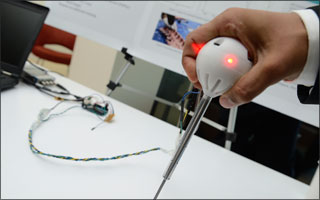As odd as it may sound, operating on the spine is a little like hanging a picture.
When it comes to manually inserting a screw into a vertebra that is mostly hidden by a patient’s flesh, surgeons must ensure the screw stays within the bone, much like perfectly landing a nail in a small stud you can’t see. In the case of a human spine, however, the slightest breach can damage the spinal cord and cause paralysis.
Enter AccuSpine, a new probe designed by a group of Johns Hopkins biomedical engineering undergraduate students who already have won $33,000 in competition prize money for their idea. The device was one of 19 medical innovations created by students and showcased at this year’s Johns Hopkins Biomedical Engineering Design Day, held on the medical campus.
Undergraduate and graduate students work yearlong on real-world problems aimed at the creation of a prototype product, system or process that meets a previously unmet biomedical need. Clinical advisors at the Johns Hopkins School of Medicine or other affiliated organizations such as Jhpiego help guide their work.
Master’s-level students, enrolled at the Center for Bioengineering Innovation & Design (CBID), work with undergrads on projects ranging from a novel way to monitor fetal heart rates to an improved controlled temperature chain to preserve vaccines. “Each year, our teams tackle some of the most challenging health care needs in the U.S. and global markets,” says Elliot McVeigh, Massey Professor and director of the Department of Biomedical Engineering.
In this undergraduate project, the AccuSpine device consists of a stainless steel probe with a peach-sized ball at one end that contains the instrument’s wiring. As the surgeon pushes AccuSpine into a vertebra to make the pilot hole for a screw, the probe measures the amount of force used to penetrate bone, which varies in density.
“There’s actually a hard bone layer that surrounds the vertebra, so when they reach that layer, that’s when the device tells them to stop because they don’t want to breach,” says team leader Anvesh Annadanam, a third-year biomedical engineering student.
The device warns the surgeon of the impending break by vibrating and flashing four red LED lights.
Annadanam
and his seven colleagues believe AccuSpine could help reduce the number of misplaced screws in spinal fusion surgeries, thereby preventing surgical complications and increased cost, as well as reducing surgeons’ reliance on X-rays to verify the positioning of spinal screws.
The team started the project in July 2013 as part of a design team class. They worked through several prototypes before arriving at the current model, which will eventually be wireless.
“Right now, the summer is going to be spent animal testing and refining the algorithm to detect breaches,” says senior Brad Isaacs.
They’ve already filed a provisional patent application and will be incorporating their company, White Light Medical, this year. They hope to eventually market AccuSpine if they can secure funding through grants and investors.
“It seems like such a simple problem, and the solution we propose is fairly intuitive, yet it’s still a new idea in the pedicle probe industry,” says freshman Erica Schwarz. “Now that we have proof of concept and our prototype working, I really hope we can move forward with it.”
— Sarah Richards

